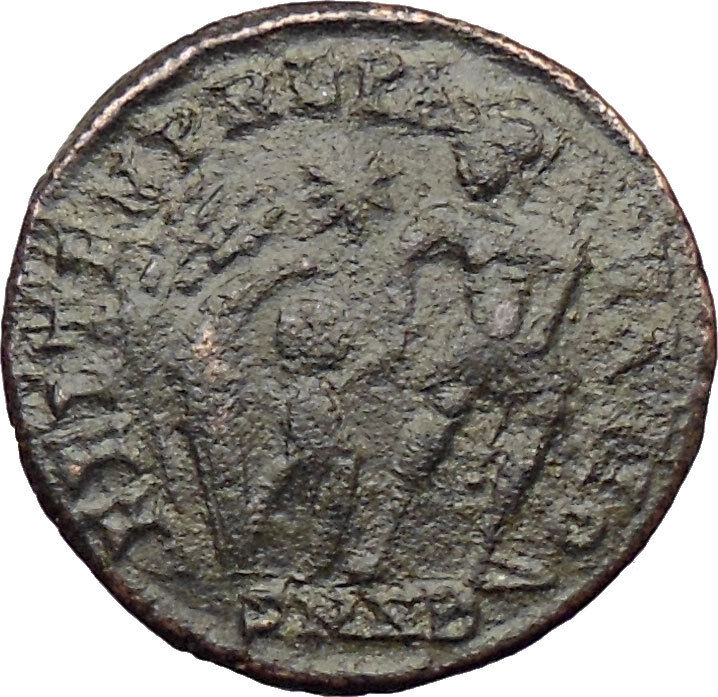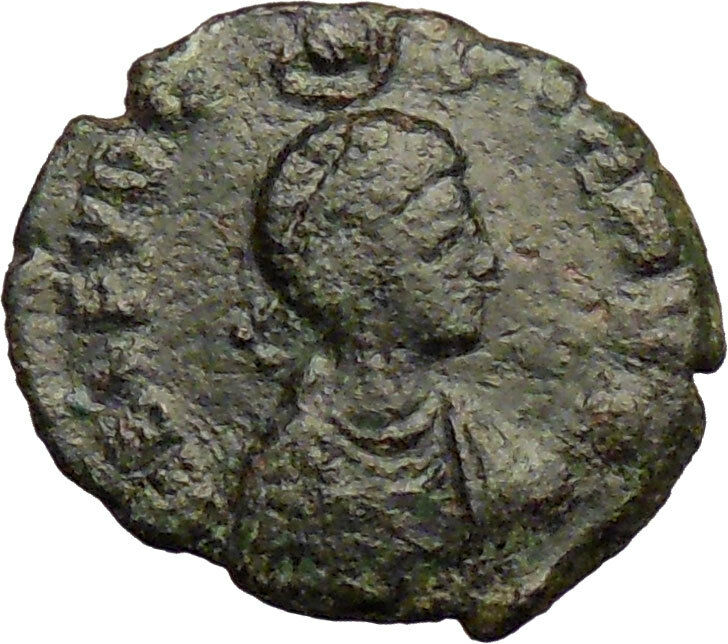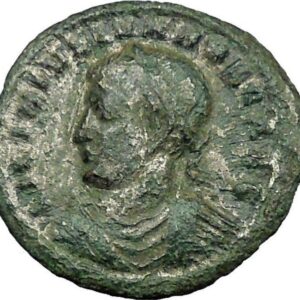|
Marcus Aurelius
–
Roman Emperor
: 161-180 A.D. –
Divus Marcus Aurelius “Deification” “Consecratio” Issue
Bronze As 25mm (9.31 grams) Rome mint: 180 A.D. under
Commodus
Reference: RIC III 663; MIR 18, 481-7/10; C 90; BM 403
DIVVS M ANTONINVS P AVG, Bare head of Marcus Aurelius right.
CONSECRATIO, Eagle standing right on globe, head left, wings spread.
You are bidding on the exact
item pictured, provided with a Certificate of Authenticity and Lifetime
Guarantee of Authenticity.
Consecration Ceremony in Ancient Rome

The
ceremony of consecration was very solemn and imposing. After the body had
been clothed in the habiliments of death, it was placed on a bed of ivory; young
men, chosen from the equestrian order, bore it on their shoulders to the pile.
The Rogus, or Funeral Pile, is described by Dion, as “a
structure in the form of a turret, with three stories, of ivory and gold, and
ornamented with statues.” Herodian describes it as a mass of quadrangular shape,
filled at the bottom with combustibles, on which again a second tier was placed
of similar form and appearance, but narrower and furnished with openings; to
this a third and a fourth were added, each gradually diminishing in size, till
the whole resembled a watch-tower.”
The corpse being then introduced into the second layer or
story, it was surrounded with aromatics and precious balms. The usual ceremonies
being completed, a torch was applied, and the mass was consumed. After this
apotheosis, the deceased emperor or empress had temples, altars, and priests
dedicated to his or her honour, and the same worship was paid to the defunct, as
paganism rendered to its gods and goddesses; whilst the Augusti, or Augustae,
were thenceforth called DIVI and DIVAE. The form of the rogus, described as
above by ancient writers, is brought to our view, with remarkable clearness, on
numerous coins. “Amongst these,” adds Eckhel, “there is one which I am told,
stands conspicuous. This is a Julia Maesa, discovered at Rome; respecting which
its then possessor, Viscount Ennius, a renowned antiquary, wrote to Garampi,
papal nuncio at Vienna, that it is so well executed, and in such high
preservation, that in the second layer of the funeral pile, the corpse of the
empress is seen recumbent on a bed; a minute particular, never before
distinguished in the monetal representation of these funeral structures.”
MARCUS AURELIUS
 Caesar: Caesar:
A.D. 139-161 under Antoninus Pius
Augustus: A.D. 161-180
A.D. 161-169 with Lucius Verus
A.D. 169-177 Sole Reign
A.D. 177-180 with Commodus
Adopted son of Antoninus Pius and heir of Hadrian
Husband of Faustina Junior
Father of Commodus, Annius Verus, Lucilla and Aurelius Antoninus
Son-in-law of Antoninus Pius and Faustina Senior
Father-in-law of Lucius Verus
Marcus Aurelius Antoninus Augustus
(26 April 121 – 17 March 180) was
Roman
emperor
from 161
to
his death in 180. He ruled with
Lucius
Verus
as co-emperor from 161 until Lucius’ death in 169. He was the last of
the “Five
Good Emperors“, and is also considered one of the most important
Stoic
philosophers. His tenure was marked by wars in
Asia
against a revitalized
Parthian Empire
, and with
Germanic tribes
along the
Limes Germanicus
into
Gaul and across the
Danube
. A revolt in the East, led by
Avidius Cassius
who previously fought alongside Lucius Verus against the
Parthians, failed.
Marcus Aurelius’ work
Meditations
, written in Greek while on campaign between 170 and 180, is
still revered as a literary monument to a government of service and duty.
Marcus Aurelius owes much of him becoming Augustus to Hadrian who
groomed him from childhood for the post. He became Caesar shortly after Hadrian
died and the political grooming continued under Antoninus Pius. He had to wait
another twenty years or so to become Augustus himself in the year 161. No sooner
did this happen than he was thrust in a series of wars that would eat up the
rest of his time in office. He died while fighting the ever-harassing tribes of
the Germanic region and power then passed to his son Commodus.
During his lengthy reign he is remembered as being among the noblest and most
even-keeled of emperors. He preferred to use the considerable power of his post
to pursue a period of enlightenment out of character not only for his age but
clear across time to our very own. Gibbon summarizes that he “was severe to
himself, indulgent to the imperfections of others, just and beneficent to all
mankind.”
Sacrificial implement:
The augur was a priest and official in the classical world, especially
ancient Rome
and
Etruria
. His main role was to interpret the
will of the gods
by studying the flight of
birds: whether they are flying in groups/alone, what noises they make
as they fly, direction of flight and what kind of birds they are. This was known
as “taking the
auspices
.” The ceremony and function of the
augur was central to any major undertaking in Roman society—public or
private—including matters of war, commerce, and religion.
The Roman historian Livy
stresses the importance of the augurs:
“Who does not know that this city was founded only after taking the auspices,
that everything in war and in peace, at home and abroad, was done only after
taking the auspices?”
A Simpulum, or Simpuvium, was a small vessel or
ladle
with a long handle from the
Roman era
, used at sacrifices to make
libations, and to taste the wines and other liquors which were poured on the
head of the sacrificial victims. The simpulum was the sign of
Roman
priesthood, and one of the insignia of
the College of Pontiffs.
The simpulum appears on a coin from
Patras
struck under
Augustus
. It is also placed before the head of
Vesta
, as a mark of that goddess, on a coin of
the Domitian
family, and is seen in the hand of a
Vestal Virgin
on coins of the
Julio-Claudian dynasty
. A man in a
toga holds a simpulum in his hand on a coin of Antonio Drusi. It is
commonly shown with the
lituus
and other sacrificial and augural
instruments, on coins of
Julius Caesar
,
Mark Antony
,
Marcus Aemilius Lepidus
,
Augustus
,
Caligula
,
Vespasian
,
Nerva
,
Antoninus
,
Marcus Aurelius
,
Caracalla
,
Publius Septimius Geta
,
Volusianus
,
Saloninus
,
Valerianus Minor
,
Domitius Calvinus
and
Pontius Pilate
, as well as on many consular and
colonial medals.
An aspergillum (less commonly, aspergilium or aspergil)
is a liturgical
implement used to sprinkle
holy water
. It comes in two common forms: a
brush that is dipped in the water and shaken, and a perforated ball at the end
of a short handle. Some have sponges or internal reservoirs that dispense holy
water when shaken, while others must periodically be dipped in an aspersorium
(holy water bucket, known to art historians as a
situla
).
An aspergillum is used in
Roman Catholic
and
Anglican
ceremonies, including the Rite of
Baptism
and during the
Easter Season
. In addition, a priest will use
the aspergillum to bless the candles during
candlemas
services and the palms during
Palm Sunday
Mass. At a
requiem
, if a casket is present, the priest
will sprinkle holy water on the casket. The aspergillum can be used in other
manners where sprinkling of holy water is appropriate, as in a house blessing,
in which the priest might bless the entry to the home. The name derives from the
Latin
verb aspergere ‘to sprinkle’.
The form of the aspergillum differs in the
Eastern Orthodox Church
. In the
Greek Orthodox Church
the aspergillum (randistirion)
is in the form of a standing vessel with a tapering lid. The top of the lid has
holes in it from which the
agiasmos
(holy water) is sprinkled. In
the
Russian Orthodox Church
the aspergillium is in
the form of a whisk
made of cloth or hair. Sometimes, sprigs
of basil
are used to sprinkle holy water. In some
of the
Oriental Orthodox Churches
, no aspergillum is
used, but the priest will pour holy water into the palm of his right hand and
throw it on the faithful.
A jug is a type of
container
for liquid. The term jug can also be
used describe the breast of a woman, due to the fact that it holds liquid. It
has an opening, often narrow, from which to pour or drink, and nearly always has
some kind of handle. One could imagine a jug being made from nearly any
watertight material, but most jugs throughout history have been made from clay,
glass, or plastic
. Some
Native American
and other tribes created liquid
holding vessels by making woven baskets lined with an
asphaltum
sealer.
The lituus was a crooked wand (similar in shape to the top part
of a crosier
) used as a cult instrument in
ancient Roman religion
by
augurs
to mark out a ritual space in the sky (a
templum
). The passage of birds through this
templum indicated divine favor or disfavor for a given undertaking.
The lituus was also used as a symbol of office for the college of the
augurs to mark them out as a priestly group.
|






 Caesar:
Caesar:


